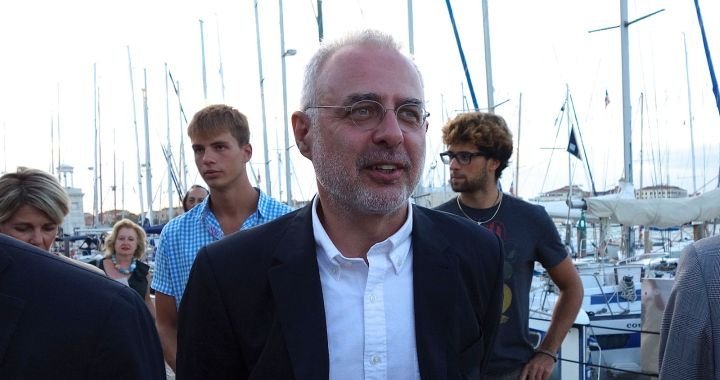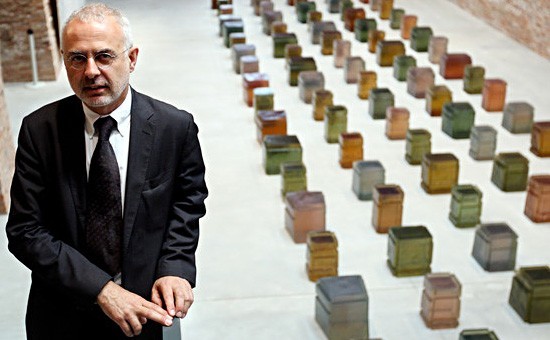
Pirates Prefer Paintings
Anna Arutyunova
16/05/2013
The V-A-C Publishing house has released Francesco Bonami’s book Lo Potevo Fare Anch’io (I could have done that too) in Russian translation. In the book, Bonami tries to figure out by what criteria the viewer can recognize artists that deserve a place in the Olympus of contemporary art. The book with its bold and irreverent generalizations can only provoke incredulous excitement on the part of the reader familiar with the history of art of the 20th century. Bonami is an experienced curator with the basic project of the 50th Venetian biennale, the third Manifesta and Whitney biennale behind him. He puts a few dozen artists, from Duchamps to Hirst, in their places and, without shying away from colourful epithets and eloquent expressions, explains why this or that author deserves a place in the history of art of the 20th century. The dust cover of the book where the author is pictured as a pirate from contemporary art with an eye-patch in the form of Malevich’s “Black Square” seems to warn us: the faint of heart should stay away. Fearlessness with which Bonami contemplates art from the heights of his success is not for the timid. His approach fully matches his idea that the first task of the artist (and in this case, the author of the book) is to provoke a reaction, no matter, bad or good.
In principle, the book is meant exactly for those who intend to make their first acquaintance with contemporary art or have just done so and now want to figure out what is what. In the introduction, Bonami, as the genuine Italian that he is, evokes a fetching analogy with the culinary arts, comparing art works with pasta, overcooked or just al dente, when talking about curators as “great chefs” or simple food servers, asserting that contemporary art is the freshest of a whole range of products.
The book consists of 33 short chapters, and almost every one of them is dedicated to one of the geniuses of the 20th century. Each has a catchy title, for instance, “Tear her up!”, if it concerns Lucio Fontana who methodically cut up his colourful canvasses, or “Found himself in Guttusdom” if the subject is the “court” painter of the communist party of Italy Renato Guttuso. Bonami never hides his excitement about or, quite the opposite, his aversion toward an artist. Thus Richard Prince with his Marlboro cowboy, in his opinion, should be counted among the great, because he managed to capture an image from the collective unconscious. Even though Bonami calls the paintings of Lucien Freud awful, he too should be placed in the list of the select, since his conservative portraits of naked people remind us of the transitory nature and brevity of life. For Bonami, who places a number of artists representing completely different currents and times in one list, the main thing is the artist’s ability to catch the viewer’s attention and impose on him or her contemplation of something big. In the last chapter, which serves to explain much, he admits to gathering a “bouquet” of very different flowers, but selecting only those that he himself considers necessary. And if the reader should be spared a sudden allergy attack, this bouquet could inspire him or her to study the individual flowers more thoroughly.

At one time you were an artist but then abandoned that occupation. If today someone suggested that you become an artist once again, would you agree?
It all depends on what kind of an artist.
What kind would you like to be?
I started with painting and now too would remain faithful to it. I have seen a lot of different art, but I would still like to do painting.
Why such loyalty to painting?
These days, you often hear how painting is supposedly dying. But in fact those who say that are confusing the terms: painting and means of expression are not the same thing. Painting is a symbolic space, like theatre or a cinema screen, which is capable of bringing out any changes. For clarity’s sake, it can be compared to footwear. One can surmise that at some point humanity will be able to do without contemporary boots, yet something will still cover our feet. It may well be a different kind of footwear, not at all what we wear today.
What, in your opinion, the painting of the future will be like?
If I had an answer to this question, I would once again become an artist. Actually, I think it will be something related to narration. A book, for instance, is a way of expressing oneself with the help of words, and it is not important if the book is printed on paper or released in electronic form. The attempt of an artist to express himself never ceases, no matter in what way this expressing himself happens. We will never stop trying to communicate.
Can we say that the documentary aspect is becoming more important in the art of today?
It has not so much to do with the documentary aspect as with the ability to tell a story and the story can be totally invented. The secret of success for any form of art is the ability to talk to many people, the striving to achieve universality of such a form of expression. Even Malevich’s “Black Square” once told a story: a story about purity and emptiness, a story that provoked his contemporaries and called into question commonly accepted norms in art.
A very broad understanding of what a story is and how it is told is thus required from the spectator .
The spectator should be made to understand that he has found himself in front of something that at that given moment is something absolutely indispensable. Like Malevich’s square in 1915. Today, in addition to provocation and contemplation of form, deeper thoughts are required. Apparently we are once again returning to the poetical in art.
Yet the artist still must provoke the spectator to contemplation?
A good artist is one who manages to put together a political message, entertainment, which today is expected of art, and the conceptuality of the execution. The universality of a work of art lies precisely in its ability to provide a space for a dialogue on completely different themes. A good artist should learn to attract an audience, to make it pay attention to him and only then, if the audience turns out to be completely incapable of receiving his message, to reject it. As spectators, we of course have to learn to react to what we see. But if an artist requires of a spectator to think first and only then react, it is not right. When a person confronts something unexpected it is natural to first react and then think. It is a kind of a self-preservation instinct. If you find yourself in the middle of the street and you see that a car is driving straight at you, you must first react – get out of the car’s way – and only then start thinking what exactly happened and who is to blame. Conceptual art is precisely a car driving straight at us.
Does painting have more of a chance to make a person feel the way you describe?
First one should learn to accept as a given reactions and sensations caused by art. Sometimes we reject contemporary art because it makes us conceptualize our sensations before we have had the opportunity to get pleasure out of them. But it does not at all mean that we must like everything, we can get mad and not agree with what we see. Of course, some feelings may be wrong, but there is nothing wrong with what we are capable of feeling. Painting creates a more understandable symbolic space: standing in front of a painting, the spectator knows exactly what is before him.
Why does such an approach not work in relation to the new media?
Sometimes it does. The main thing is for an artist to use the media to create new art instead of masking old ideas as innovations, the way Bill Viola does, for instance. He is an artist who is trying to be contemporary on account of the means he uses instead of the language he speaks or the content of the message. The subject matter dedicated to taking Christ off the cross does not become contemporary only because it is shot by a camera in slow motion. Street art is often just bad painting on walls. And video art tends to be bad painting processed by a computer. It is bad when media is trying to become a painting.